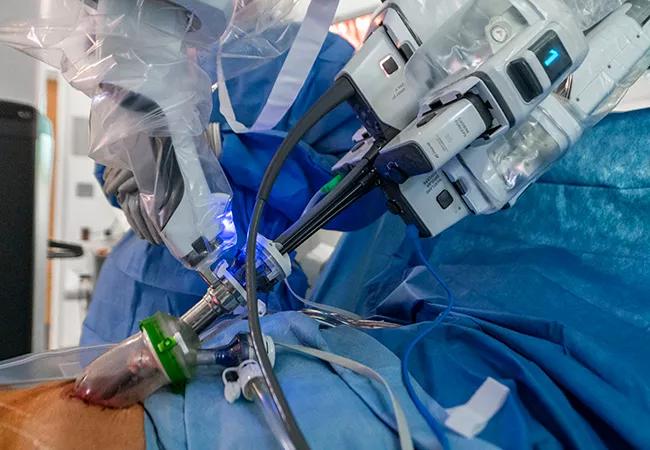Early experiences and outcomes on the brink of 200 cases

Cleveland Clinic was the first U.S. medical center to begin using the single-port (SP) robot for urologic procedures in late 2018. Since then, experts at Glickman Urological & Kidney Institute continue to fine-tune their surgical technique.
Advertisement
Cleveland Clinic is a non-profit academic medical center. Advertising on our site helps support our mission. We do not endorse non-Cleveland Clinic products or services. Policy
Jihad Kaouk, MD, Director of the Center for Robotic and Image-Guided Surgery and the Zegarac-Pollock Endowed Chair in Laparoscopic and Robotic Surgery, elaborates on the benefits of performing the prostate cancer surgery extraperitoneally, noting, “By avoiding the sac in which the bowel is contained, the surgery is compartmentalized, limited to the area just around the prostate. The gas bubble in which the robotic arms work expands the peritoneum, pushing the bowel out of the way, allowing better visibility.”
In addition, the SP robotic technique avoids the steep Trendelenburg positioning, which improves recovery time and mitigates potential risks associated with such positioning, including optical nerve edema, congestion and respiratory problems during surgery. Patients undergoing the procedure with SP robotic prostatectomy lie flat. They experience a single incision, versus the five incisions required in a patient’s abdomen in previous robotic radical prostatectomy procedures.
These key differences in the SP robotic technique allow for easier extraperitoneal access, which helps avoid intra-abdominal adhesions. The technique also avoids assistant ports. Improved recovery aspects of the SP robotic procedure include decreased opioid use (70 percent of patients do not use opioids), an increase in same-day discharges with a median hospital stay of 4.8 hours, no drains and no reported ileus, with good functional and oncologic outcomes. Nearly 90 percent of patients were continent at six months.
Advertisement
The team shared their experience using the SP robot to perform extraperitoneal radical prostatectomy in 185 cases at the American Urological Association 2021 Annual Meeting.
Advertisement
Advertisement

First-of-its-kind research investigates the viability of standard screening to reduce the burden of late-stage cancer diagnoses

Global R&D efforts expanding first-line and relapse therapy options for patients

Study demonstrates ability to reduce patients’ reliance on phlebotomies to stabilize hematocrit levels

A case study on the value of access to novel therapies through clinical trials

Findings highlight an association between obesity and an increased incidence of moderate-severe disease

Cleveland Clinic Cancer Institute takes multi-faceted approach to increasing clinical trial access 23456

Key learnings from DESTINY trials

Overall survival in patients treated since 2008 is nearly 20% higher than in earlier patients